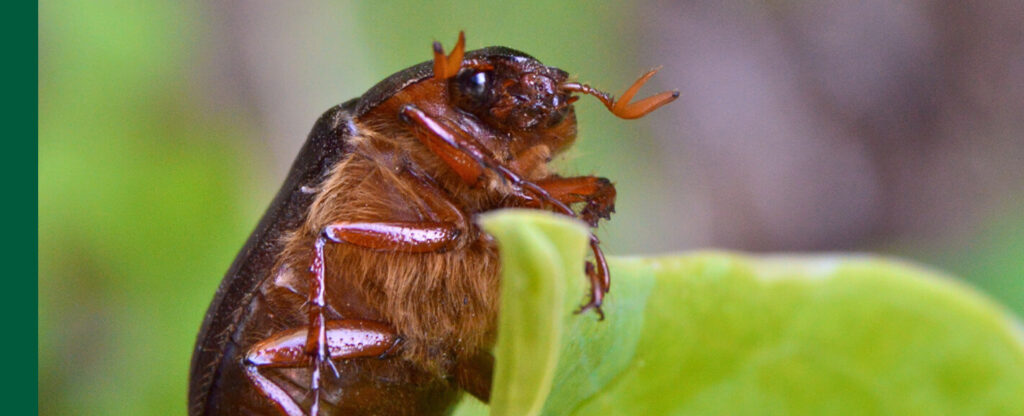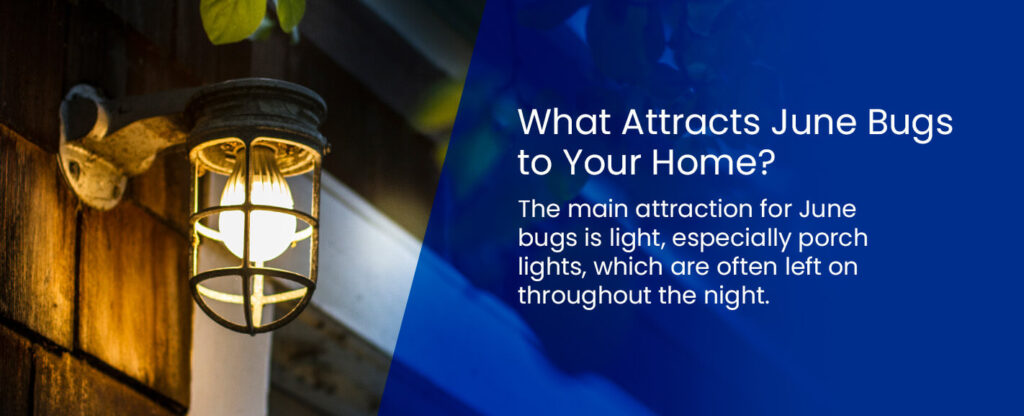
Pests that make your porch or patio their home are a nuisance for numerous reasons, especially those that fly and land everywhere. One such bug that’s native to the United States is the June bug or June beetle. This minuscule irritant can make your time spent lounging outdoors unpleasant, often requiring bug spray or professional pest treatments.
There shouldn’t be a battle for who gets to enjoy the outdoors. Your porch is yours to relax and relish the evening sunset and natural light. We’ve listed a few tips on how to keep flying bugs away, specifically the June bug, that should help you eradicate these tiny unwanted guests.
What Are June Bugs?
June bugs or beetles also go by the name of May bugs, mostly because they develop into fully grown adults by the time summer starts in June so they can feed on abundant foliage and fruit. They lay up to 200 eggs in the soil, which hatch after about 18 days towards the end of summer. These larvae look like white grubs with black heads and can cause considerable damage to plant roots and lawns, despite their size.
The complete life cycle lasts about three years from the time the grub develops until they are ready to emerge as adults and mate. Adults live for approximately a year before dying.
Physical Characteristics and Diet
You can identify them by their small, oval-shaped brown-black, red-brown or mahogany bodies that vary between 12 and 25 millimeters long. They have antennas and shiny wings spun across their backs with hairy underbodies. Adult June bugs mostly feast on vegetables, fruit and foliage, so gardeners should be aware of their presence and the potential damage they can cause. The larvae or white grubs can wreak havoc in your backyard as they devour grass and roots that make up their main diet.
June bugs are not harmful to humans and animals as they do not bite, but they are a flying pestilence, especially when they make their way onto your porch or patio on warm summer evenings.
What Attracts June Bugs to Your Home?

The main attraction for June bugs is light, especially porch lights, which are often left on throughout the night. Light provides a sense of navigation, drawing them in naturally. The rich food source your yard or garden provides also sustains them and their eggs as it offers protection and a breeding ground when they need it.
You may find an increase in June bugs if your lawn is strewn with thatch that is ideal for grubs to feed on. Chemicals like pesticides and fertilizers are lethal to other pests but encourage root growth, providing further sustenance for June bug larvae.
What Months Are June Bugs Most Active?
June bugs are mostly active in the spring and summer months between May and June when it’s warmer and food is readily available. They feed when they emerge after spending the winter buried beneath the soil.
How Do You Identify June Bugs and Their Grub?
Besides identifying them physically by the way they look, you may notice June bugs and their larvae around your house. Keep an eye out for the following signs:
- Sporadic brown grass patches on your lawn: Larvae eat grass roots, so you may notice your grass gradually turning brown and dying.
- Small holes across your lawn: Predators, like moles seeking grubs, may make holes in your lawn, leaving you with an additional problem.
- Garden plant leaves riddled with tiny holes: Adult June bugs feed off plants and foliage, so you might discover the leaves filled with tiny holes.
Tips to Get Rid of June Bugs on Your Porch or Patio
You can do a few things to help you get rid of June bugs on your porch or patio. Consider these tips and how you can effectively rid your porch and possibly your yard of these pests.
1. Replace the Porch Light Bulbs
June bugs are attracted to light but generally struggle to identify light outside of the 300 to 650 nanometer range. LED lights may be efficient enough to mislead the bugs since these orange or yellow bulbs fall outside their detectable light sensory scope. If you’re lucky, they might fly right past the light as if it wasn’t there at all.
2. Set Up a June Bug Trap
You can trap adult June bugs naturally by mixing half a cup of molasses and half a cup of water in a container with a funnel neck. The sweet scent lures them inside, where they will eventually drown in the concoction. This method ensures adults won’t mate but might not be effective against large infestations.
3. Introduce Nematodes to Your Soil
June bug larvae are nutritional and essential for soil worms called nematodes to thrive. They provide a natural alternative to eradicating larvae populations. The nematodes should be mixed with water and distributed across the lawn during the summer when grubs are most prevalent for maximum impact.
Depending on the severity of the larvae infestation, you may need to reapply the nematodes periodically over the span of at least three years, the average time it takes for June bugs to complete their life cycle.
4. Disperse Milky Spores in the Fall
Areas with moist soil are best for a bacterium called milky spores to help control grubs. The solution contains the spores mixed with water that is dispersed across the lawn, similar to nematodes. It should be applied in cooler climates as dry soil won’t be effective.
5. Encourage Natural Predation
Birds, bats, toads, nonvenomous snakes and other predators will help control the presence of June bugs and their larvae. Create a bird-friendly environment that will attract them to your lawn or garden by minimizing fertilizers that kill off some of the natural predators in the area.
6. Keep A Clean Porch and Lawn
Anywhere dirt accumulates could be a potential spot for June bugs and other critters to hide while they scurry for food. Since the light initially attracts them to the porch area, they may come across sand, dirt, food, leaves and other debris that could be confused for food sources. By sweeping the dirt and keeping your porch clean, you minimize the chances of bugs roaming around and hiding in it.
Stagnant water or leaks on the porch are an additional source all types of bugs may seek for nourishment. They don’t only need food but water to survive, so any available water source will attract them. Checking for and remedying leaks and drying water puddles will help keep them away.
You would also benefit from dethatching your lawn regularly to ensure grubs and adult June bugs can’t nest and feed on the organic matter thatch is made of.
Let Garrety Glass Build Your Screen Room to Keep Out Flying Pests
When the warmer seasons approach and you’re ready to enjoy the outdoors without the burden of flying bugs and other pests, call Garrety Glass to install a screen room that will keep them all at bay. You won’t have to worry about June bugs disrupting your evening as you savor the sunsets.
Whether you’re in Pennsylvania, York or Maryland, our professional team is ready to help you install the perfect screen room to enhance your patio or porch. Contact us for a free quote so we can discuss your home’s requirements.
